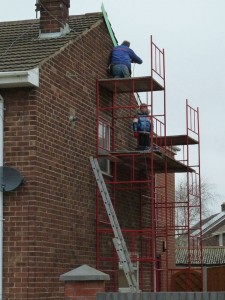Falls from Heights
Falls from heights are the largest contributors to serious injuries and fatalities at building and construction sites. Most of these incidents are entirely preventable with a risk assessment and the use of appropriate equipment. Ladders are some of the simplest equipment that can be used, yet surprisingly their misuse is the cause of most incidents.
How Practical Is the Use of Ladders at Heights?
Ladders are a common feature in nearly every sector of employment. Falls usually occur when they are used for the purposes for which they were not designed. They are recommended for use where the risk involved is low, the work is expected to take a short duration, and the workplace has fixtures and features that cannot be adjusted to accommodate other equipment.
Whenever there is work at heights, you should do a risk assessment to determine what kind of work equipment is most suitable for use. Ladders are especially critical when scaffolding to prevent falls. They achieve this purpose when they are of sufficient lengths to provide safe handholds and when the ladder access openings between scaffold levels are arranged in the right manner.
A Scaffolding Firm Falls because of a Ladder
On 14 March 2014, Watford Magistrates’ Court fined Beacon Scaffolding Ltd, of Gloucester Avenue, London £5,000 and ordered it to pay £1,737 in costs for a single breach of the Construction (Design and Management) Regulations 2007.
The Health and Safety Executive (HSE) investigations revealed that Beacon Scaffolding had been sub-contracted to erect scaffolding around a four-storey block of flats at Evans Wharf, Aspley Lock so that painters and decorators could safely repaint the woodwork and windows. On 6 November 2012, 48-year-old David Currie was working on the flats when he fell through an unprotected ladder opening and suffered a fractured arm and dislocated shoulder.
HSE prosecuted the scaffolding firm on site for safety failings. The painting and maintenance sub-contractors had asked the Beacon workers to increase the height of the first scaffolding tier significantly, but the scaffolders had continued erecting the scaffolding before the alterations necessary for the new layout design had been received.
Mr. Currie, a self-employed painter and decorator from Lisson Grove, London, was working on the third scaffold tier when he lost his footing and fell through an unprotected ladder opening to the second level below, suffering serious injuries.
The Rules of Using Ladders
The first rule is to do a workplace risk assessment. When you have ascertained that a ladder is the most suitable equipment for use, get the right ladder and position it for stability. Check that the surface upon which the ladder rests has the strength, firmness, and stability to support it, with the steps or rungs remaining horizontal.
Some ladders are portable and these can slip, resulting in injuries. These ladders require that you first prevent their movement before anyone steps on them. You should use a stability device, such as a suitable anti-slip device, or secure the stiles around the lower and upper ends of the ladders.
There are ladders designed to be suspended, and these should be securely attached so that there is no swinging or displacement when they are in use. If you are using extension or interlocking ladders, first ensure that all sections are attached firmly to prevent their movement relative to each other.
Work at heights often involves a vertical distance exceeding nine metres. The ladders used should always be longer than the vertical distance of the place of landing they give access to. Handholds should also be added and rest platforms or safe landing areas provided at suitable intervals from the base. Basically, every ladder being used should have secure support and handholds even when the user is carrying a load.
David Currie’s fall could have been prevented had Beacon Scaffolding Ltd had the right measures put in place. For one, the access ladders between the scaffold levels should have been sufficiently long to provide fitting handholds above the landing places. There should also have been guardrails or ladder traps to prevent falls through the scaffold levels.
Cover All Your Bases
There is much you can do to protect your employees from falls when they are working at heights, but sometimes accidents are inevitable. You can get professional guidance on what to do and not to do when you are dealing with work equipment and work at heights from our health and safety consultants. Just call them today on 0800 1488 677. Help reduce workplace risks and protect lives.

A chartered (fellow) safety and risk management practitioner with 20+ years of experience. David provides a healthy dose of how-to articles, advice and guidance to make compliance easier for construction professionals, Architects and the built environment. Get social with David on Twitter and Linkedin.



